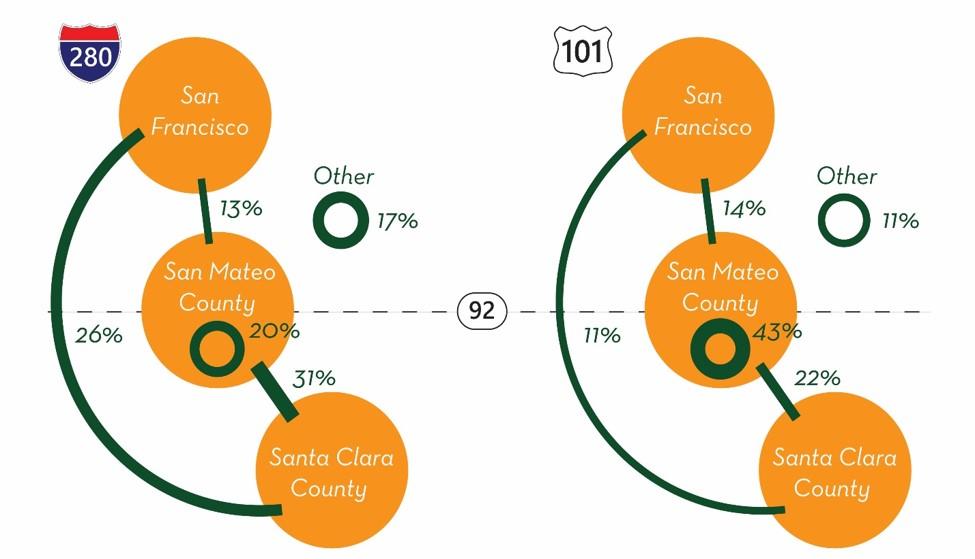By Alex Eisenhart | @AlexOnTransit
 As commuters are well aware, US-101 through San Mateo, San Francisco and Santa Clara counties is one of the most infamously congested freeway corridors in the Bay Area. The steep regional spike in new jobs (about 254,000 between 2008 and 2015 in San Francisco, San Mateo and Santa Clara Counties) have outpaced the development of new housing on the Peninsula. In addition to increased congestion for local commuters, more folks who work on the Peninsula are forced to live further and further away from it, further compounding our traffic problems. It’s an intimidating challenge. SamTrans is working to be part of the solution. Cue the US-101 Express Bus Study. SamTrans is exploring the role express buses can play in providing commute options on US-101 and adjacent roadways like I-280 to strengthen connectivity between jobs and housing hubs throughout the region. The Study launched in April, 2017 and the SamTrans Board of Directors adopted the Study in December, 2018, thereby kicking off the process for implementation. This is not the first time San Mateo County has embraced the express bus concept. SamTrans used to run a network of express bus routes up until the Great Recession in 2009. Today’s unique economic and transportation landscape offers new opportunities to address highway congestion through express bus service. From the robust study came some interesting key findings. Here’s just some of things we learned:
As commuters are well aware, US-101 through San Mateo, San Francisco and Santa Clara counties is one of the most infamously congested freeway corridors in the Bay Area. The steep regional spike in new jobs (about 254,000 between 2008 and 2015 in San Francisco, San Mateo and Santa Clara Counties) have outpaced the development of new housing on the Peninsula. In addition to increased congestion for local commuters, more folks who work on the Peninsula are forced to live further and further away from it, further compounding our traffic problems. It’s an intimidating challenge. SamTrans is working to be part of the solution. Cue the US-101 Express Bus Study. SamTrans is exploring the role express buses can play in providing commute options on US-101 and adjacent roadways like I-280 to strengthen connectivity between jobs and housing hubs throughout the region. The Study launched in April, 2017 and the SamTrans Board of Directors adopted the Study in December, 2018, thereby kicking off the process for implementation. This is not the first time San Mateo County has embraced the express bus concept. SamTrans used to run a network of express bus routes up until the Great Recession in 2009. Today’s unique economic and transportation landscape offers new opportunities to address highway congestion through express bus service. From the robust study came some interesting key findings. Here’s just some of things we learned:

- 43% of commute trips on US-101 start and end in San Mateo County, compared to 20% on I-280.
- Of vehicle trips on US-101 that cross State Route 92 (CA-92), 36% occur between San Mateo County and San Francisco (14%) or Santa Clara Counties (22%).
- Of vehicle trips on I-280 that cross CA-92, 44% occur between San Mateo County and San Francisco (13%) or Santa Clara Counties (31%).
- About 70% of San Mateo County residents drive alone to work, compared to 36% in San Francisco County.
- Most commute trips on US-101 are less than 10 miles.
- I-280 typically serves longer distance trips than US-101 during peak hours.
- US-101 serves 20-25% more vehicles than I-280 during peak hours.
- There are 550 private express bus and employer shuttle trips per day on US-101.
- 86% of respondents surveyed as part of the Study said it was very important that they be able to transfer between different transit lines/routes.
- 67% of respondents surveyed said they preferred to be within walking distance from an express bus stop. A majority also said they’d be willing to walk up to 10 minutes to an express bus stop.
So, what’s next? SamTrans is preparing to implement the recommendations from the US-101 Express Bus Study, which include a phased launch of six new express routes. Recommended routes serve multiple communities of concern in San Francisco and on the Peninsula as defined by the Metropolitan Transportation Commission. The first express buses are expected to begin service later this year with a bi-directional route between Foster City and San Francisco. Eventually they’ll use electric buses (thanks in part to a $15 million grant from the State) but will start with existing diesel and/or hybrid electric buses. Following completion of the San Mateo County Express Lanes Project, SamTrans buses will be able to use the express lanes for improved reliability and travel time in an effort to better meet the needs of peninsula commuters.
###
Alex Eisenhart is a Public Affairs Specialist with the San Mateo County Transit District’s Communications Department.
